South of the border
Jackie Macadam learns more about the work of our churches in England and the Channel Islands.
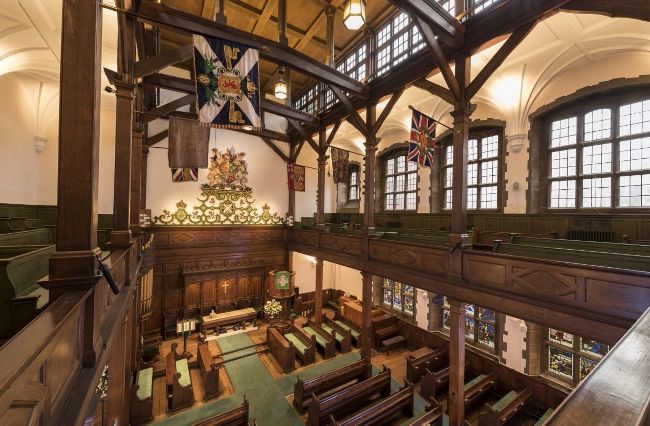
Crown Court Church, Covent Garden London
THERE are a lot of jokes about the relationship between Scotland and England, and it’s fair to say that it has had its moments.
One thing has stood irm – the Church of Scotland and its churches south of the border – from Berwick and Carlisle in the north to the Channel Islands in the south.
Whilst it’s easy to focus on our own backyards, sometimes we can lose track of what’s going on with our closest neighbours, and the problems they face in the same-but-diferent parishes they are part of in England. Being a minority church where another is predominant is not without its own challenges.
The Rev Angus MacLeod, minister, St Columba’s Pont Street, London, explained:
“Addressing the General Assembly of the Church of Scotland, in 1883, the Session Clerk of the ‘new’ St Columba’s Church in London asked: ‘Do you never relect that there are probably more Scotchmen in London, than in any city of Scotland? Is not London the heart of the Empire? Is she not the magnetic centre that attracts to herself the highest intelligence and the accumulated wealth of the kingdom? And is it not there, of all other places that the Church of Scotland should strive to maintain a strong and inluential Representative Church?’
“Over a hundred years on, St Columba’s, like its sister congregations in the Presbytery of England, still seeks to gather and nurture Scots, Presbyterians and others, from across London and far beyond.
“The majority of those attending worship have some Scottish connection – be it irst, second or third generation. That identity is celebrated in other ways – Scottish Country Dance groups, Burns Night Suppers and congregational ceilidhs.
“But the congregation also enjoys and is enriched by the presence of Presbyterians from around the globe, who during their time in London, seek worship in a style familiar from home.
“With the membership spread wide, the majority of congregational life centres round Sunday – worship, congregational lunch each week for members and homeless guests, a regular afternoon programme of talks or music recitals, and during the winter a Night Shelter, run as part of a circuit of west London churches.
“During the week the halls are busy – used by local schools, support groups, church groups and commercial hirings. This places a heavy demand on the building and the staf who administer it, but it also ensures that the there is ‘a lot of life going on under its roof.’
“Being in London, there is considerable opportunity to collaborate with other groups. In 2017 St Columba’s was one of twelve, mainly Reformed tradition congregations, which came together to mark Reformation 500. A monthly ‘doorstep event’ hosted by each congregation, gave the chance to cross several new thresholds; in turn, ofering welcome to many who had not visited St Columba’s before. More recently there has been involvement with a ledgling Interfaith Forum for the Royal Borough of Kensington & Chelsea.
“In 2018, the story of the hospitality ofered to nearly 50,000 Scottish troops, transiting through the London railway stations of World War I, was the catalyst for Scots in Great War London. A collaboration of ten London-based, Scottish organisations – congregational, charitable, regimental, sporting and social – produced an autumn packed with events.
“St Columba’s tries to remain faithful, welcoming and engaged – ofering a home away from home to those who seek it.” The Rev Graeme Glover is minister at St Columba’s in Jersey.
“Be honest,” he says. “When I mention Jersey to you, what comes to mind? “Loads of rich people? Maybe you think that the words ‘Be honest’ and ‘Jersey’ should not even be in the same sentence – what with the reports about tax evasion and all.
“And here’s a question for all the parish ministers reading. When I tell you that my normal week consists of only one Sunday service, have no school assemblies and only the occasional funeral, does that ill you with empathy?
“Would it change your mind to know that on this small island there are 10,000 Scots? “Would it change your mind to know that there are 20,000 Portuguese people and that many are working two or three jobs and live in bedsits?
“Does it help to know that we feel God’s calling, through our many actions, to be a good neighbour?
“Would it change your mind to know that the Church of Scotland, in being one of the smaller denominations here, has no choice but to work well with other churches?
“That, through taking part in as many island-wide initiatives as we can, we are gaining invaluable experience in how to be greater than the sum of our parts?
One of the main challenges for St Ninian’s from day one and still today is to create a sense of community. Not everyone that came from Scotland was a member of the Kirk.
“We feel like there is much we can do with the church in Scotland.
“We want to ofer holiday trips for groups, as well as a community vineyard project to provide prayerfully-produced communion wine to send freely to other churches.
“Would it change your mind about your ideas of Jersey life to know that there are many new clergy coming into the island, a weekly prayer meeting for revival and a feeling that God is moving?
“That there are sixty or seventy people of diferent nationalities each week at our service, with new people coming. In our church we can feel God giving us a sense of life. And work.
“In fairness, I also sometimes question why the Church of Scotland is in Jersey. The answer I can come up with is just what I see: that God is doing something here and we seem to be part of it. Maybe, that’s the best answer I can come up with. If I am to be honest.”
But the Church of Scotland is hard at work among the more challenged places in England as well.
Corby, in the East Midlands, has strong historical ties with Scotland. “St Ninian’s, Corby was established in the 60s and 70s in a new estate where thousands of Scottish people were moving to for the steelworks,” says the Rev Kleber Machado, minister at the church.
“Roughly half of the congregation came from the west of Scotland, especially from the Glasgow area. Those people were struggling to ind employment in Scotland and were attracted to Corby because here there were plenty of jobs with the steelworks. Another half came from east Scotland, especially the Aberdeen area. There the issue was not to ind a job, but it was a shortage of housing, where in Corby they could get a brand new house in a few days.
“The church was very important to give the newcomers a sense of belonging.
“One of the main challenges for St Ninian’s from day one and still today is to create a sense of community. Not everyone that came from Scotland was a member of the Kirk. Some were Baptists, others from the Salvation Army, and even some from the Scottish Episcopal Church, but when they arrived instead of looking for a congregation of their own denomination, they became part of the Church of Scotland.
“This ofered the church an opportunity but also a challenge. How to be a church for people with so diferent views about faith and spirituality? St Ninian’s has to be a welcoming place where people with diferent faith stories can grow in faith. We are a church that tries to incorporate diferent styles of worship and stimulates mutual understanding.
“The Church, of course, is in England and the idea that the Church of Scotland plays or could play a central part in the community is not clear-cut. In the irst years everyone still looked at the Church of Scotland as their parish church, but nowadays, to be a church that brings people together and ofers everyone a place for building relationships with each other and especially with the transcendent is a duty as well as a challenge.
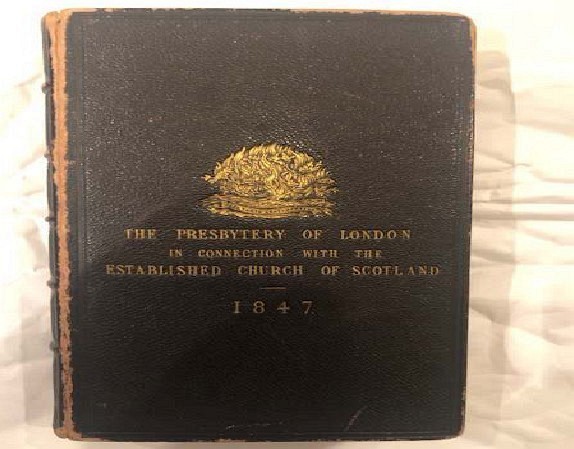
First book of the Presbytery of London
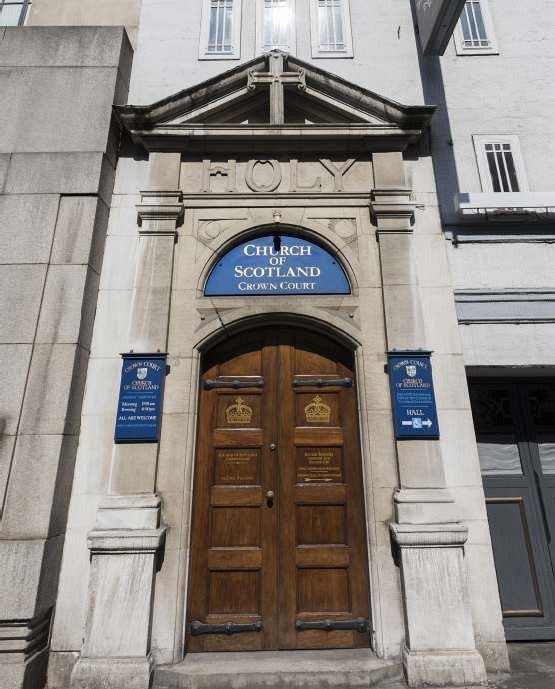
Crown Court Church, Covent Garden London
“In the last years St Ninian’s managed to build a good relationship with the primary school in the area and they come to church for special services at Harvest, Christmas, Easter, for concerts and also for other activities.
There is a brand new school for children with learning disabilities in the area and the church is already in contact with this school and the children will come to celebrate their Christingle service at St Ninian’s later this year. We also have a community carol service when the major councillors, police representatives, schools and other community leaders come to participate. We also have groups of Scouts, Brownies, and Guides meeting every week in the Church’s hall. “The area is basically formed by working class people and there are some areas of social deprivation as well. The church tries hard to address the issues involved in this context.
“With the Church of England we run the food bank. And we also support the local Home Start projects and visit every other week diferent care homes. In the last couple of years we started Messy Church which has been very successful in this regard because it brings together families from diferent backgrounds nine times a year to play together, to have a meal together, and also to worship together. In the last session we had over 60 people between children and adults. And now the newcomers are not Scottish only, but instead they come from other countries of Europe or even from other continents. Even though we are not in Scotland we work very much as a parish church in Scotland.”
Crown Court Church is situated in Covent Garden in the heart of London’s theatreland, and a stone’s throw from Westminster and Whitehall.
“We’re the original Church of Scotland in London and are surrounded by theatres, restaurants, shops and Covent Garden market and Piazza, all very diferent from the days when the lower market was situated here,” says Sheila Haddon, the Church Secretary.
“The area has changed hugely over the years, and the residential accommodation in the neighbourhood has largely gone upmarket. We are a gathered congregation, with members travelling great distances from all over London and the south-east to attend church. So we are not a parish in the traditional sense: indeed, it could be said that the south of England is our parish!
“Our current church building dates back to 1909, but the original church on the site was opened for worship on March 24 1719, so 2019 sees us celebrating our Tercentenary Year. Our theme for the year is ‘celebrating and renewing 300 years of service in Covent Garden’.
“We are planning a number of celebratory events, including a special service on March 24, at which the Moderator of the General Assembly will preach, a ball, garden party, lower festival and ceilidh.
“We are running an anthem composition competition and hope to be able to include the winning composition as part of the special service.
“But we have more on our plate than celebrations. Our diverse community means we have people around us who need help.
“We have launched a pilot project together with The Connection at St-Martin-in-the Fields, the Passage and the West London Mission, to provide accommodation for a fortnightly meeting for homeless women to come together and experience various activities in a safe space. The charities are experiencing an increase in the number of female homeless people, and they lack suitable accommodation where the women can meet in a space which is just for them, so they particularly appreciate being able to use our hall which provides plenty of space and the facility for a variety of activities.
“In addition to this project, we continue our connection with the local residents, who use the church hall for meetings and attend events such as the annual Christmas market, which is always a popular occasion. We have also renewed our connection with Bruce House.
“This was formerly a hostel for homeless people, but was closed for a long time for renovation, and now houses a number of charities providing a variety of services.
Amongst them, we are particularly involved with Centrepoint, which provides accommodation and training for young homeless people to help them get back on their feet, ind work and eventually move out into their own accommodation.
“Every Sunday we welcome visitors from Scotland and all over the world, so would be particularly pleased to see lots of visitors during our tercentenary year. We have already contacted all congregations in Scotland, and have seen a number of visitors as a result of this approach. If you’re in London during 2019, or any other time, do come and see us – you’ll be made most welcome.”
Further north, Irene Wilkinson is the Session Clerk of St Andrew’s Kirk in Newcastle “As always each year that passes seems to get busier than the one before.
This year we have focused on our Garden Ministry as we welcomed the community around us, including the businesses in the vicinity, into our garden. Members come regularly, to weed, tidy, do any repairs to the garden walls and seating. The community comes to eat lunch in lovely surroundings, chat and to enjoy the tranquility of our city oasis.
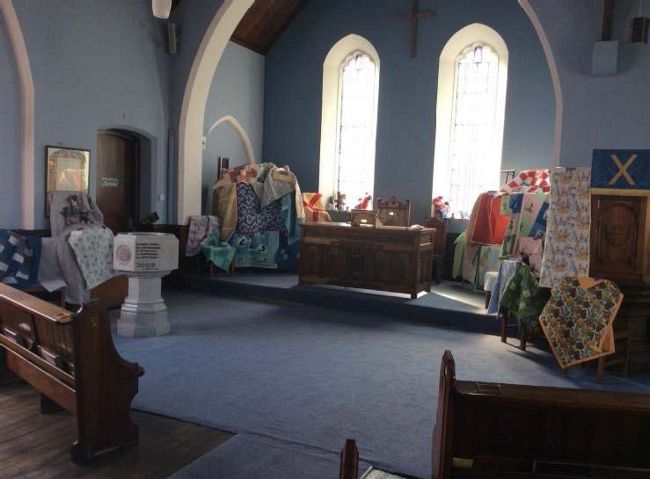
St Andrews, Newcastle on Tyne by Rev Dorothy Lunn
The craft group has ventured into quilting making over thirty Linus quilts for children in hospital with life-limiting illnesses. “This has been a learning curve for us all as we learned new skills. The group have also knitted premature baby hats, Trauma Teddies for the police to give to traumatised children after accidents or incidents in the home.
“We also spent some time making stufed animals and Christmas table runners to go out to families who are recipients of help from the two food banks we support.
These gifts have been warmly welcomed by those who run the food banks who say that these gifts are a way of showing that we really do care about those to whom the food bank is a lifeline throughout the year but especially at Christmas. These handmade gifts were welcomed with open arms and we got lots of hugs to share with the congregation.
“In our spare moments we also knitted enough poppies to decorate the Sanctuary, vestibule and garden for Remembrance Sunday.
“At the moment we are being challenged, as a congregation, having an OLM (Ordained Local Minister) probationer. He is young, has new ideas and makes us think about the direction of the church. He is also, with the support of Kirk Session, planning to trial ‘Open Church’ early in the New Year.” Not all English Church of Scotland congregations are in the Presbytery of England.
“Presbyterianism has a long and distinguished history in Berwick-Upon Tweed and area,” says the Rev Adam Hood of St Andrew’s Wallace Green and Lowick Church in Berwick-upon-Tweed.
“The Reformer, John Knox ministered for two years in Berwick and in the 19th century, John Cairns, one of the leading Scottish churchmen of the time was minister for 30 years at Wallace Green church. St Andrew’s Wallace Green and Lowick continues this tradition. There are some unique facets to our congregation. One is that we are located in England, but part of Duns presbytery.
In fact, given that folks living in our area move easily back and forward over the border for work, shopping and recreation, our situation seems perfectly sensible. In practice, folk living near to the border have more similarities than diferences. Again, since we are based in England, we are not a parish church. However, a large part of the local population have a Scottish connection, so that we play a quasi parish role. This is relected in the various opportunities for community and civic service that we enjoy.
The annual town Remembrance Service alternates between St Andrew’s and Berwick Parish Church; we host the yearly Armed Forces Day Service; and periodically we are the venue for ‘Mayor’s Sunday’. Alongside these more formal avenues of ministry, the congregation, with a membership of 280, maintains a vibrant witness of worship and service.
The church is known for its friendliness, care, generosity and willingness to work hard. One example was our recent ‘Remembrance Project’, which involved research into all of the people named on our WW1 memorial tablets, as well as hosting a Remembrance Concert. The congregation is also a willing partner with congregations of other denominations in the town and locality.”
And the Rev David Pitkeathly who is minister of The Border Kirk, Carlisle echoes these views. “There have been Church of Scotland congregations in Carlisle and Longtown for more than 180 years and people of Scottish birth and ancestry live, work, practise their hobbies and socialise in signiicant numbers in the Great Border City and its hinterland.
“While we may engage most frequently with those holding a Scottish connection, our doors are open to people of all backgrounds and many born and bred Cumbrians seem over the years to have valued our style of worship and our aim to ofer hospitality in Christ’s name.
“We would not want to be seen just as a gathering place for Scots but as an outward looking community of faith serving the area with our fellow Christians.
“It is an immense joy to be a companion Church within the Cumbria Churches Ecumenical Covenant and so much of what we ofer is done and can only be done in pooling resources with friends from other denominations.
We would not want to be seen just as a gathering place for Scots but as an outward looking community of faith serving the area with our fellow Christians.
“One example is a monthly service provided for those with dementia and their carers ofered jointly by the United Reform Church and ourselves.
“We combine talents too with other Christians in providing Messy Church style events, in supporting the very stretched food bank, in ofering pastoral visiting within the area hospital and in mission initiatives such as the recent cafe stall at the City Christmas market.
“In Carlisle, we are blessed to have a particularly lexible and contemporary building at the heart of the City and it provides a base for caring projects such as a Mencap Cafe, homeless breakfasts and a lunch club for the lonely elderly. In Longtown numbers are small but we share in worship, in pastoral support and in various children’s outreach activities with the Methodist congregation.
We participate fully in the life of Annandale and Eskdale presbytery sharing a youth worker with congregations just over the border and our Guild also relish opportunities for cross border fellowship and service.” Guernsey is another island that boasts a strong Church of Scotland presence.
“Many Life and Work readers will know something of Guernsey but some context may be helpful. Guernsey is approximately 26 square miles in area, so slightly smaller than Tiree, and our population is 62,000 – roughly the same as Inverness,” says Hilary Boyle, Session Clerk to the church.
“There are over 60 faith groups in the island, almost all representing Christian denominations. The established church is the Church of England, with 14 places of worship, and there are about a dozen Methodist congregations, with a wide variety of other denominations. St Andrew’s in the Grange is the only Church of Scotland congregation.
We are very much in the minority numerically, but strive to punch above our weight when it comes to community life. “Perhaps because of its island status, and perhaps because of its wartime occupation, Guernsey has retained a strong sense of community where one’s neighbour is one’s neighbour, regardless of religious beliefs.
There is a strong understanding that by working together we can achieve so much more than by individual initiatives, particularly important because we have a very much slimmer state sponsored welfare structure than in the United Kingdom.
“Most here enjoy a good standard of living, but there are still many who rely on charitable support so, yes, there is a Food
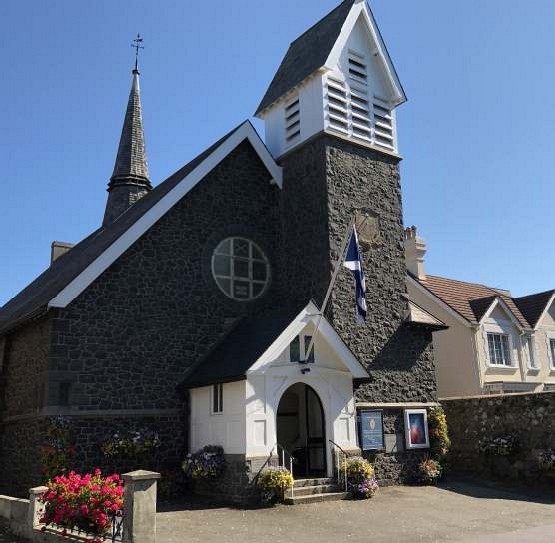
Guernsey Church of Scotland
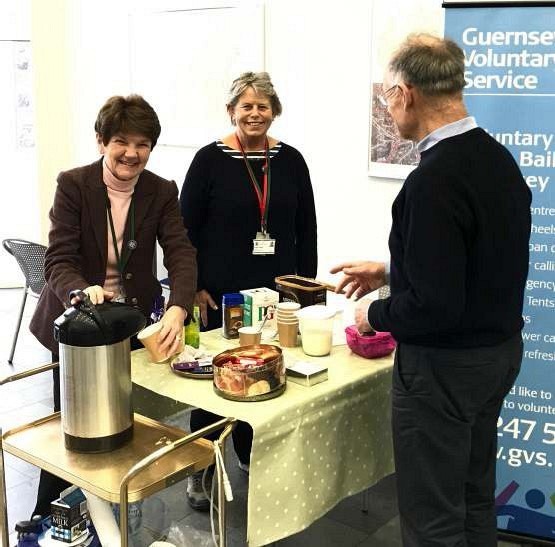
Volunteering at Guernsey Church of Scotland
Bank, housed in and organised by an Anglican congregation, but supported by many others including ourselves. We have a permanent collection point from which donations are transferred regularly, in addition to supporting this initiative through special collections during the pre-Christmas period.
“Similarly, members individually are heavily involved in supporting the elderly, lonely, and housebound through engagement with the Guernsey Voluntary Service’s provision of day care centres, meals on wheels, and drivers for those needing transport to appointments. One GVS initiative run almost entirely by St Andrew’s in the Grange volunteers is a cofee stall for those attending the local court, an idea suggested by a Judge to try to reduce the amount of stress involved in attending court.
“Others act as Street Pastors at weekends in St Peter Port, or help in charities shops in the island supporting Christian Aid, the RNLI (our lifeboat is an essential feature of island life here), the Samaritans, ActionAid, etc.
“We have, however, been able to progress some projects as an individual congregation. Island life makes us very aware of the increasing pollution of the sea, and has led us to engage in regular beach cleaning exercises.
“Recently, we have also supported appeals to help in assisting ofenders and ex-ofenders to reintegrate back into island life. We were happy to be able to employ as a painter one man preparing for parole, providing him with both new company and transport daily for a fortnight. We also recruited a young girl to work with members in crocheting poppies for the Remembrance display at our front door. When she saw the inished display, her new-found sense of achievement and self-respect had a huge emotional efect on her.
And speaking as if to voice the whole essence of the Church of Scotland in England, she says: “It is be easy to sound self-congratulatory and complacent, but we do know that there will always be so much more to do …”